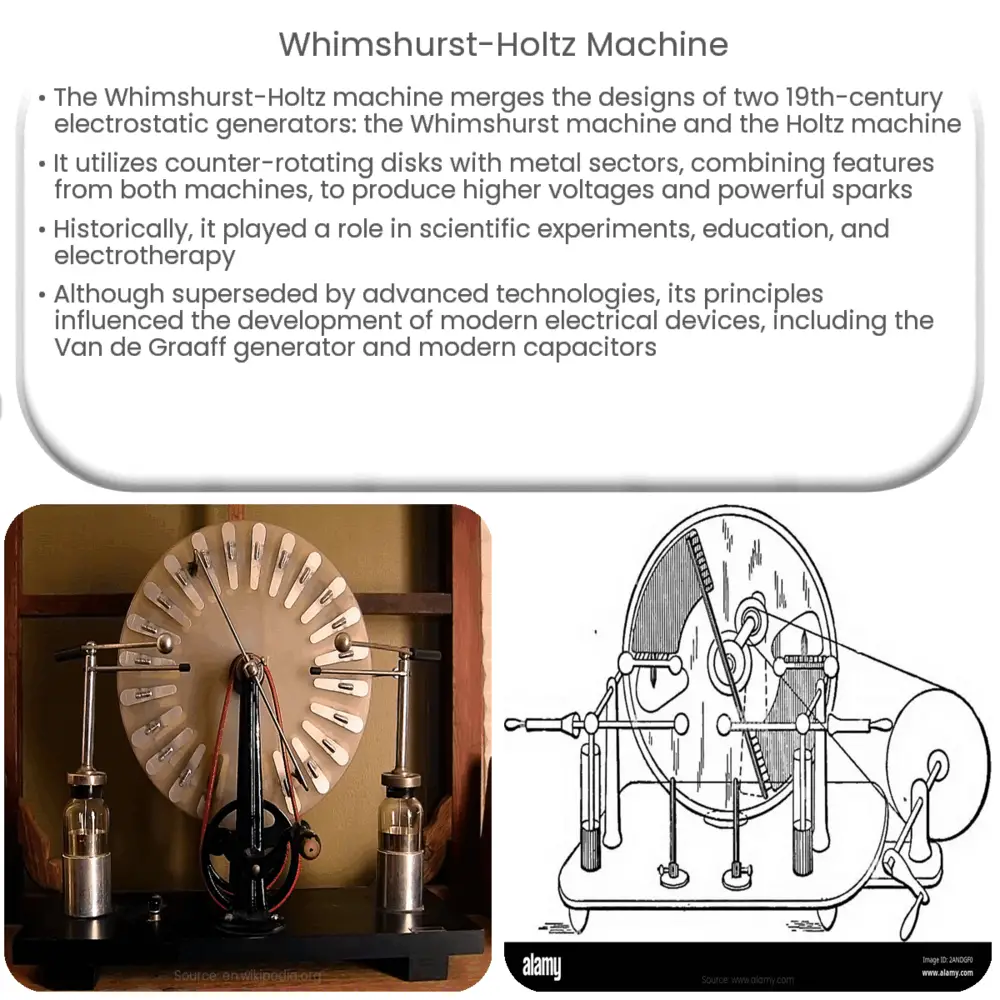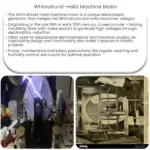The Whimshurst-Holtz machine is a hybrid electrostatic generator that combines elements of Whimshurst and Holtz machines, producing high voltages and powerful sparks.

Whimshurst-Holtz Machine: A Historical Overview
Introduction
The Whimshurst-Holtz machine is a fusion of two classic electrostatic generators, the Whimshurst machine and the Holtz machine. Both were invented in the late 19th century and were used for various applications, including scientific experiments, demonstrations, and electrotherapy. In this article, we explore the history, design, and working principles of the Whimshurst-Holtz machine, as well as its impact on the development of modern electrical technology.
The Whimshurst Machine
Invented by British inventor James Whimshurst in 1880, the Whimshurst machine is an electrostatic generator that produces high voltages through a process known as influence. It consists of two large counter-rotating disks mounted on a common axis, with metal sectors attached to their surfaces. A pair of brushes, each connected to a Leyden jar, are placed in contact with the metal sectors. The Leyden jars act as capacitors, storing the generated electrical charge. As the disks rotate, they induce opposite charges on the sectors, which are then collected by the brushes and stored in the Leyden jars. When the voltage across the jars becomes sufficiently high, a spark is produced, demonstrating the accumulation of electrical charge.
The Holtz Machine
Developed by German physicist Wilhelm Holtz in 1865, the Holtz machine is another electrostatic generator that operates on the principle of influence. It features a single glass disk mounted on a central axis, with metal sectors attached to both sides of the disk. A pair of brushes, connected to Leyden jars, contact the metal sectors on one side of the disk, while two inductor plates, also connected to Leyden jars, are placed opposite the brushes on the other side of the disk. As the disk rotates, the inductor plates induce charges on the metal sectors, which are then collected by the brushes and stored in the Leyden jars. Like the Whimshurst machine, the Holtz machine generates high voltages that can produce sparks across a gap.
Combining the Whimshurst and Holtz Machines
The Whimshurst-Holtz machine is a hybrid design that combines elements from both the Whimshurst and Holtz machines. It features two counter-rotating disks, like the Whimshurst machine, with metal sectors attached to both sides, similar to the Holtz machine. Brushes and inductor plates are placed in contact with the metal sectors on opposite sides of the disks, allowing for the collection of electrical charges through influence. The resulting machine is capable of producing higher voltages and more powerful sparks than either the Whimshurst or Holtz machines alone.
Applications and Legacy
During the late 19th and early 20th centuries, the Whimshurst-Holtz machine was widely used in scientific experiments, educational demonstrations, and electrotherapy treatments. Its ability to produce high voltages made it an ideal tool for studying electrical phenomena, and its striking visual appearance captured the imagination of both scientists and the public. Although the Whimshurst-Holtz machine has been largely superseded by more advanced technologies, it remains an important historical artifact that provides a glimpse into the early development of electrical engineering.
Working Principle of the Whimshurst-Holtz Machine
The Whimshurst-Holtz machine operates on the principle of electrostatic induction, also known as influence. As the counter-rotating disks turn, the metal sectors on one disk pass closely to the inductor plates on the other disk. This causes the inductor plates to induce opposite charges on the metal sectors. As the disks continue to rotate, the charged sectors come into contact with the brushes, transferring the charge to the Leyden jars. The accumulated charges in the Leyden jars create a potential difference, which can result in a spark discharge when the voltage becomes sufficiently high.
Modern Replicas and Demonstrations
Today, the Whimshurst-Holtz machine is primarily used for educational purposes and as a historical artifact. Modern replicas of the machine can be found in museums, science centers, and educational institutions, where they serve as a demonstration of electrostatic principles and as a testament to the ingenuity of early electrical engineers. The machine’s striking appearance and ability to produce sparks continue to captivate audiences, providing an engaging and hands-on learning experience for students of all ages.
Impact on Modern Electrical Technology
While the Whimshurst-Holtz machine is no longer used for practical applications, its legacy is evident in the development of modern electrical technology. The machine’s demonstration of high-voltage generation through electrostatic induction laid the groundwork for subsequent advancements in electrical engineering, including the development of the Van de Graaff generator and the Tesla coil. Additionally, the concepts of capacitance and charge storage demonstrated by the machine’s Leyden jars contributed to the development of modern capacitors, which are integral components in many electronic devices and systems.
Conclusion
The Whimshurst-Holtz machine represents an important milestone in the history of electrical engineering, combining elements from two pioneering electrostatic generators to create a device capable of producing high voltages and powerful sparks. Though it has been largely supplanted by more advanced technologies, the machine remains a fascinating historical artifact that serves as a reminder of the early days of electrical science. Its continued use in educational demonstrations and museum exhibits highlights its lasting impact on our understanding of electricity and the development of modern electrical technology.




